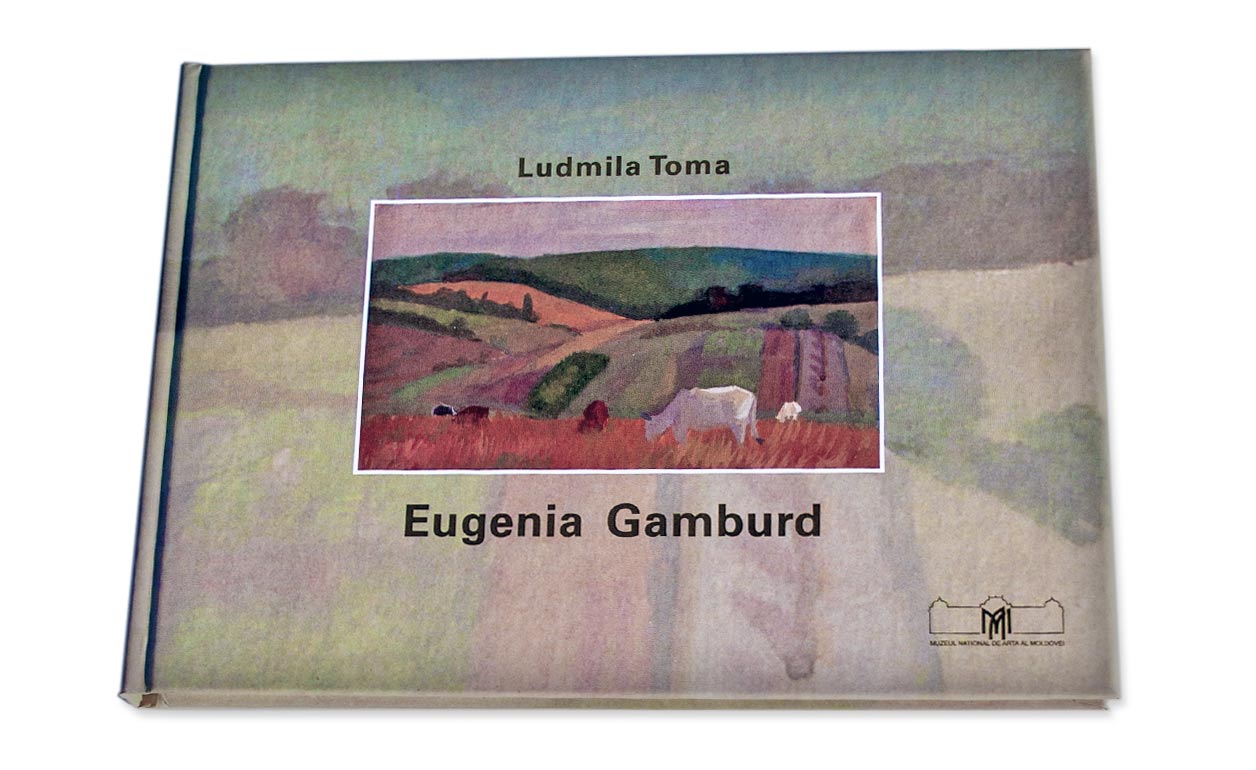The album contains about 56 colored reproductions of Eugenia Gamburd’s gouaches and documentary material. The text is in English, Romanian and Russian.
The album was edited in 2007 by the National Art Museum of the Republic of Moldova, with support of the House of the Bessarabian Jewry and in cooperation with the artist’s daughter. 143 pages, 23,5/17 cm.
The monograph “Eugenia Gamburd” is an album-like book about the life and creative work of Eugenia Gamburd (1913-1956). The author is Ludmila Toma, Doctor of the History and Theory of Fine Arts, with the participation of Miriam Gamburd.
The work of Eugenia Gamburd (1913-1956) occupies a special place in the artistic life of Moldavia of the postwar decade. Her paintings – intimate, lyrically infused and far from ideological considerations – did not fit into the rigid boundaries of Social Realism. An artist of rare coloristic talent, she painted according to the dictates of her heart, oblivious of party censors. She earned a livelihood and gained social recognition in the sphere of stage costume design.
The highly developed plastic culture evident in Eugenia Gamburd’s work is based on the traditions of French and Romanian art. A graduate of the Bucharest Academy of Art (1936, Art Department, headed by Professor J. A. Steriadi), she trained in France (1937). In 1938 she married the famous artist Moisey Gamburd and lived with him for two years in Bucharest, exhibiting her canvases in shows mounted by the Official Salons of the Bessarabian Arts Society.
In the summer of 1940, with Moldavia annexed and incorporated into the Soviet Union and Europe under the sway of Nazi Germany, Eugenia and her husband returned to Kishinev. War, evacuation and relocation, years of hunger, the oppressive atmosphere of Stalinist ideology – these were the vicissitudes of day-to-day life through which Eugenia Gamburd remained a painter. Her spiritual refuge became the lyrical landscape, and it is here that we observe the consummation of her artistic talents.
Moscow during the war years, seen from the ‘bird’s-eye’ view of the upper story of a hotel (1943); the ruins of Moldavian towns and villages (1944-1945) – these urban and rural landscapes are fascinating as historical documents, while also displaying true artistic value. The harmony of full-bodied color chords is here akin to the consonances of a musical composition.
The pathos of Social Realism was foreign to Eugenia Gamburd, although she did attempt to bring her paintings thematically up to date by working the labor motif into several landscapes (for example, in the ‘Reconstruction of Kishinev’ series, 1947). She was much more engrossed by problems of composition and color. Acutely sensing the unique qualities of the Bessarabian countryside – the musical cadence of its hills and fields, the softness of its light linking earth and sky – she created singular images reflecting the finest nuances of spiritual experience. The exquisite combination of adjacent hues corresponds to a complicated worldview as in rural landscapes from the 1950s.
It is surprising how expertly Eugenia Gamburd handles gouache, a technique unpopular with painters because of its opacity. This drawback she turns to her advantage. A muted yet fresh, uniquely refined color arrangement merges through the employment of a chromatic background overlaid with a thin layer of transparent glue, glimmering here and there with a warm sunny glow if the paper beneath it is brown or a cold silvery one, if blue.
Although the artist was not in open political opposition, her consistent disregard of ideology, considered obligatory during the Stalinist era, was seen by party demagogues in an extremely negative light. In 1948 she was demoted from the status of member of the Artists’ Union to candidate. Her privileges were not restored even after the official recognition of her contribution in the sphere of Moldavian national theater costume (in the form of a state honorary citation bestowed in 1950).
Eugenia Gamburd achieved widespread acclaim for her work as artistic designer in the film ‘Andriesh’ (1954, released by the Dovzhenko Film Studio), directed by Sergei Paradjanov and based on a fairy tale by Moldavian poet Emilian Bukov. Her work as a scenographer and artist specializing in Moldavian costume and folklore, alongside one of the major directors of the 20th century, occupies a special chapter in her oeuvre. Today, film festivals worldwide featuring the work of Sergei Paradjanov open with screenings of ‘Andriesh’, a cinematic masterpiece shelved for nearly half a century.
The research and popular dissemination of the best works of Eugenia Gamburd as part of the cultural heritage of Moldavia will help fill out, and, in a certain sense, rectify, the current conception of artistic developments in the republic during the difficult and dramatic period of the 1940s and early 1950s.
Works by Eugenia Gamburd are displayed in the National Art Museum of the Republic of Moldova, in the National Archive of the Republic of Moldova, in the Michail Grobman’s collection in Tel Aviv and in the private collection of Miriam Gamburd, the artist’s daughter, in Tel Aviv.
Information about Eugenia Gamburd:
- Soviet Art Films. Annotated catalogue. Vol.3, Moscow 1961, p.518.
- Artists of the USSR’s nations. Bibliographical dictionary. V.2, Moscow 1972, p.405.
- P. Oprea. Expozanţi la Saloanele Oficiale de pictură, sculptură grafică (1924-1944). Bucureşti, 2004. p.47.
- Allgemeines Künstler – Lexicon, K.G. Saur, München – Leipzig, vol. 48, 2006, p.263.
